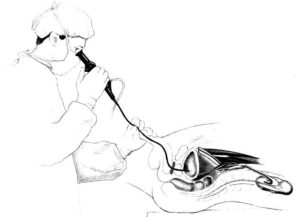URETEROSCOPY AND LASER STONE FRAGMENTATION
This is a commonly performed procedure to eliminate urinary tract stones (also known as calculi) from the ureter or the kidney.
It is a very safe and precise procedure with a very low complication rate and a high success rate. Very occasionally, usually due to a patient’s anatomy, it may not be possible to reach a stone in the first instance. If this is the case, Dr Patel will arrange repeat or alternative treatment for you.
It is normal to experience some pain or discomfort in the immediate post-operative period, but it is usually performed as day surgery, and you should be able to go home on oral analgesia.

A flexible ureteroscope can be passed right up into the kidney to laser a stone
Under a general anaesthetic, a very thin instrument, called a ureteroscope, is introduced through the urethra and bladder and then up the ureter to the stone. Once the stone is located, a laser fibre (less than 1mm in diameter) is introduced through the scope and used to fragment the stone into very small pieces that are small enough to wash out of the urinary tract.
Sometimes, some of the stone fragments may be extracted at the time of surgery and sent for analysis.
Depending on the position of the stone, either a semi-rigid or flexible ureteroscope may be used.
At completion of the procedure, a temporary drainage device is usually left internally, called ureteric stent. This is a thin plastic tube with a coil at either end. The stent spans the ureter from the kidney to the bladder, and temporarily helps the kidney to drain as well as helping small stone fragments to pass. The stent will need to be removed in the weeks after your treatment. Usually this requires another, very quick, procedure in hospital.
Ureteric stents are fully internal but can often cause variable symptoms such as increased frequency and urgency of urination, some pain or discomfort in your flank or groin and intermittent blood in the urine. None of these symptoms are dangerous but they can be irritating, and therefore every effort will be made to remove your stent without excessive delay. However, stents usually need to be left in place for about 1-6 weeks. You should always ensure that arrangements have been made for your stent to be removed.
If you have any questions or concerns regarding an upcoming procedure or if you have recently had a procedure performed, you should contact Dr Patel’s office.
Download a printer friendly version of this page
